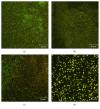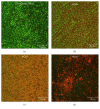Enhanced Performance and Mode of Action of a Novel Antibiofilm Hydrofiber® Wound Dressing
- PMID: 27990437
- PMCID: PMC5136405
- DOI: 10.1155/2016/7616471
Enhanced Performance and Mode of Action of a Novel Antibiofilm Hydrofiber® Wound Dressing
Abstract
Biofilm development in wounds is now acknowledged to be a precursor to infection and a cause of delayed healing. A next-generation antibiofilm carboxymethylcellulose silver-containing wound dressing (NGAD) has been developed to disrupt and kill biofilm microorganisms. This in vitro study aimed to compare its effectiveness against various existing wound dressings and examine its mode of action. A number of biofilm models of increasing complexity were used to culture biofilms of wound-relevant pathogens, before exposure to test dressings. Confocal microscopy, staining, and imaging of biofilm constituents, total viable counting, and elemental analysis were conducted to assess dressing antibiofilm performance. Live/dead staining and viable counting of biofilms demonstrated that the NGAD was more effective at killing biofilm bacteria than two other standard silver dressings. Staining of biofilm polysaccharides showed that the NGAD was also more effective at reducing this protective biofilm component than standard silver dressings, and image analyses confirmed the superior biofilm killing and removal performance of the NGAD. The biofilm-disruptive and silver-enhancing modes of action of the NGAD were supported by significant differences (p < 0.05) in biofilm elemental markers and silver donation. This in vitro study improves our understanding of how antibiofilm dressing technology can be effective against the challenge of biofilm.
Conflict of interest statement
The authors declare that they have no competing interests.
Figures











Similar articles
-
Clinical and in vitro performance of an antibiofilm Hydrofiber wound dressing.J Wound Care. 2018 Sep 2;27(9):584-592. doi: 10.12968/jowc.2018.27.9.584. J Wound Care. 2018. PMID: 30204577
-
Use of internally validated in vitro biofilm models to assess antibiofilm performance of silver-containing gelling fibre dressings.J Wound Care. 2020 Mar 2;29(3):154-161. doi: 10.12968/jowc.2020.29.3.154. J Wound Care. 2020. PMID: 32160088
-
Antimicrobial activity of a bioelectric dressing using an in vitro wound pathogen colony drip-flow reactor biofilm model.J Wound Care. 2016 Jul 1;25(Sup7):S47-S52. doi: 10.12968/jowc.2016.25.Sup7.S47. J Wound Care. 2016. PMID: 29027847
-
Restoring balance: biofilms and wound dressings.J Wound Care. 2018 Feb 2;27(2):102-113. doi: 10.12968/jowc.2018.27.2.102. J Wound Care. 2018. PMID: 29424642 Review.
-
Managing biofilm by using dressings.Br J Community Nurs. 2015 Jun;Suppl Community Wound Care:S10, S12. doi: 10.12968/bjcn.2015.20.Sup6.S10. Br J Community Nurs. 2015. PMID: 26052989 Review.
Cited by
-
Activity of silver-zinc nanozeolite-based antibiofilm wound dressings in an in vitro biofilm model and comparison with commercial dressings.Discov Nano. 2025 Feb 11;20(1):26. doi: 10.1186/s11671-025-04208-8. Discov Nano. 2025. PMID: 39932517 Free PMC article.
-
3D Biofilm Models Containing Multiple Species for Antimicrobial Testing of Wound Dressings.Microorganisms. 2022 Oct 13;10(10):2027. doi: 10.3390/microorganisms10102027. Microorganisms. 2022. PMID: 36296303 Free PMC article.
-
Development of Rapid and Economic In Vitro Assay and Biorelevant Ex Vivo Biofilm Inhibition Wound Model to Test the Antibacterial Efficacy of Wound Dressings.Wound Repair Regen. 2025 Jul-Aug;33(4):e70080. doi: 10.1111/wrr.70080. Wound Repair Regen. 2025. PMID: 40827061 Free PMC article.
-
Assessment of the Antibiofilm Performance of Silver-Containing Wound Dressings: A Dual-Species Biofilm Model.Cureus. 2024 Sep 24;16(9):e70086. doi: 10.7759/cureus.70086. eCollection 2024 Sep. Cureus. 2024. PMID: 39449882 Free PMC article.
-
Alternative Approaches for the Management of Diabetic Foot Ulcers.Front Microbiol. 2021 Oct 5;12:747618. doi: 10.3389/fmicb.2021.747618. eCollection 2021. Front Microbiol. 2021. PMID: 34675910 Free PMC article. Review.
References
-
- Bowler P., Jones S., Towers V., Booth R., Parsons D., Walker M. Dressing conformability and silver-containing wound dressings. Wounds UK. 2010;6(2):14–20.
MeSH terms
Substances
LinkOut - more resources
Full Text Sources
Other Literature Sources

